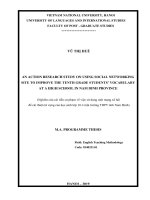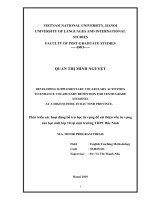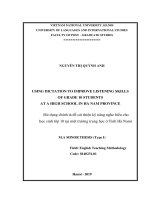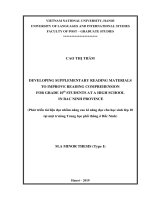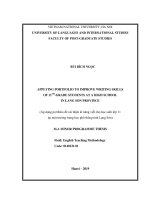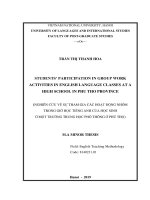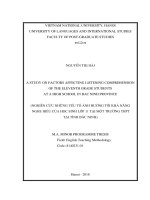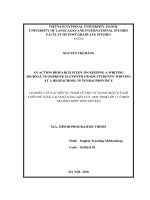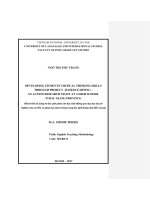An action research study on keeping a writing journal to improve the eleventh grade students’ writing at a high school in yen bai province
Bạn đang xem bản rút gọn của tài liệu. Xem và tải ngay bản đầy đủ của tài liệu tại đây (970.39 KB, 80 trang )
VIETNAM NATIONAL UNIVERSITY, HANOI
UNIVERSITY OF LANGUAGES AND INTERNATIONAL STUDIES
FACULTY OF POST GRADUATE STUDIES
NGUYỄN THỊ HẰNG
AN ACTION RESEARCH STUDY ON KEEPING A WRITING
JOURNAL TO IMPROVE ELEVENTH GRADE STUDENTS' WRITING
AT A HIGH SCHOOL IN YENBAI PROVINCE
(NGHIÊN CỨU CẢI TIẾN SƯ PHẠM VỀ VIỆC SỬ DỤNG NHẬT KÝ GHI
CHÉP ĐỂ NÂNG CAO KHẢ NĂNG VIẾT CỦA HỌC SINH LỚP 11 Ở MỘT
TRƯỜNG THPT TỈNH YÊN BÁI)
M.A. MINOR PROGRAMME THESIS
Field: English Teaching Methodology
Code: 8140231.01
HÀ NỘI- 2018
VIETNAM NATIONAL UNIVERSITY, HANOI
UNIVERSITY OF LANGUAGES AND INTERNATIONAL STUDIES
FACULTY OF POST GRADUATE STUDIES
NGUYỄN THỊ HẰNG
AN ACTION RESEARCH STUDY ON KEEPING A WRITING
JOURNAL TO IMPROVE ELEVENTH GRADE STUDENTS' WRITING
AT A HIGH SCHOOL IN YENBAI PROVINCE
(NGHIÊN CỨU CẢI TIẾN SƯ PHẠM VỀ VIỆC SỬ DỤNG NHẬT KÝ GHI
CHÉP ĐỂ NÂNG CAO KHẢ NĂNG VIẾT CỦA HỌC SINH LỚP 11 Ở MỘT
TRƯỜNG THPT TỈNH YÊN BÁI)
M.A. MINOR PROGRAMME THESIS
Field:
EnglishTeaching Methodology
Code:
8140231.01
Supervisor: Vũ Thị Thanh Nhã, PhD.
HÀ NỘI - NĂM 2018
DECLARATION
I, the undersigned, hereby certify my authority of the study project report
entitled " An action research study on keeping a writing journal to improve 11th
grade students’ writing at a high school in Yen Bai province" submitted in partial
fulfillment of the requirements for the degree of Master in English Teaching
Methodology. Except where the reference is indicated, no other person‟s work has
been used without due acknowledgement in the text of the thesis.
Hanoi, 2018
Nguyen Thi Hang
Approved by
SUPERVISOR
...............................................
i
ACKNOWLEDGEMENTS
This thesis could not have been completed without the help and support from
a number of people.
First and foremost, I would like to express my sincere gratitude to Vu Thi
Thanh Nha, PhD, my supervisor, who has patiently and constantly supported me
through the stages of the study, and whose stimulating ideas, expertise, and
suggestions have inspired me greatly through my growth as an academic researcher.
Next, a special word of thanks goes to Mrs Phan Thi Kim Phuong- my
collaborator and many others, without whose support and encouragement it would
never have been possible for me to have this thesis accomplished.
Last but not least, I am greatly indebted to my family, my husband and my
children for the sacrifice they have devoted to the fulfillment of this academic work.
ii
ABSTRACT
This research is the investigation of the predominant problems in learning
writing at a high school in Yenbai province and the implementation of new
technique to deal with situation, which, in this case, is journal writing. The primary
purpose of the study is an attempt to find out how to apply journal writing in
teaching writing to the 11th grade students and to what extent the journal writing
impacted on the students‟ attitudes and their writing performances. Action research
was adopted in research and conducted in two cycles: cycle 1 and cycle 2. The
study data were collected by means of informal interviews, observation checklists
and field notes. The result indicated that the problems in students were the lack of
practice, low writing attitudes, ideas limitation, lexico- grammar mistakes. After
implementing the journal writing, analysing the collected data, it finds that (1) there
were positive changes in students‟ attitudes toward writing (2) there was an
improvement of the time to generate ideas in students. Two weaknesses were found
out at the first cycle: first, some students were demotivated and reluctant to write.
Second, many students found difficulties in vocabulary mastery and grammar
structures. Dealing with those weaknesses, the researchers used grammar review
strategy. The findings showed that the students were motivated in writing and
writing journals, they also got progress of the students‟ writing performances.
Moreover, students built themselves their own writing habits as well as created an
intimate study environment in class.
iii
LIST OF ABBREVIATIONS
L1: First language
L2: Second language
CEFR: Common European Framework for Reference
M.A : Master of Arts
VNU: Vietnam National University
GCSE: General Certificate of Secondary Education
LIST OF TABLES
Table 3.1.Number of students with scores below average .......................................41
Table 3.2. Time to think about the ideas in students.................................................39
Table 3.3. Students' positive attitudes and negative attitudes toward journal .........45
LIST OF CHARTS
Chart 3.1. Manifestation of students‟ attention to the teacher‟s lecture ...................37
Chart 3.2. Manifestation of the students‟ positive response to journal writing ........37
Chart 3.3. Negative attitudes .....................................................................................38
Chart 3.4. Time to think about the ideas in students .................................................40
iv
TABLE OF CONTENTS
Contents
Pages
DECLARATION ......................................................................................................... i
ACKNOWLEDGEMENTS ........................................................................................ ii
ABSTRACT ............................................................................................................... iii
LIST OF ABBREVIATIONS .................................................................................... iv
LIST OF TABLES ..................................................................................................... iv
LIST OF CHARTS .................................................................................................... iv
PART A: INTRODUCTION ..................................................................................1
1. Rationale ..............................................................................................................1
2. Aims of the study .................................................................................................3
3. Research questions ...............................................................................................3
4. Methods of the study ...........................................................................................3
5. Scope of the study ................................................................................................3
6. Significance of the study .....................................................................................4
7. Design of the study ..............................................................................................4
PART B: DEVELOPMENT.....................................................................................6
CHAPTER ONE: LITERATURE REVIEW......................................................6
1.1. Introduction .................................................................................................6
1.2. Writing .........................................................................................................6
1.3. Approaches of teaching writing ................................................................7
1.3.1. The controlled writing approach .............................................................7
1.3.2. The freewriting approach ........................................................................8
1.3.3. The paragraph-pattern approach .............................................................8
1.3.4 .The process approach ..............................................................................9
1.3.5. The communicative approach ...............................................................10
1.4 . Writing assessment ...................................................................................11
v
1.5. Journal .......................................................................................................13
1.5.1. Definitions of journal ............................................................................13
1.5.2. Benefits of Journal writing....................................................................14
1.5.3. Overview of previous studies related to journal in teaching writing ....14
1.6. Recount texts .............................................................................................17
1.6.1. Social functions of Recount texts .........................................................18
1.6.2. Generic structures of Recount texts ......................................................18
1.6.3. The language features of Recount texts ................................................19
1.7. Conceptual framework .............................................................................19
CHAPTER TWO : METHODOLOGY ............................................................21
2.1. Introduction ...............................................................................................21
2.2. Research setting .........................................................................................21
2.2.1 Description of school and facilities........................................................21
2.2.2 Description of the students.....................................................................21
2.2.3. Description of English teachers ............................................................22
2.2.4. Description of textbook, curriculum, testing and assessment ...............22
2.4. Research design .........................................................................................23
2.4.1. Research method ...................................................................................23
2.4.2. Action research .....................................................................................23
2.5. Research Instruments ...............................................................................25
2.5.1. Observation checklist ............................................................................25
2.5.2. Fieldnote................................................................................................25
2.5.3. Semi structured interview .....................................................................26
2.5.4. Pre -test and students' journals ..............................................................26
2.6. Techniques of analyzing the data .............................................................27
2.7. Time of the research ..................................................................................28
CHAPTER THREE : RESEARCH FINDINGS...............................................29
3.1. Introduction ...............................................................................................29
vi
3.2. Identifying the problem ............................................................................29
3.2.1 . Observation ..........................................................................................29
3.2.2. Interviews ..............................................................................................30
3.2.3. Pre- test .................................................................................................31
3.3. Research process........................................................................................33
3.3.1.Cycle I....................................................................................................33
3.3.1.1. Treatment ........................................................................................33
3.3.1.2. Observation .....................................................................................36
3.3.1.3. Reflection........................................................................................42
3.3.2.Cycle II ..................................................................................................42
3.3.2.1. Plan .................................................................................................42
3.3.2.2. Action .............................................................................................43
3.3.2.3. Observation . ...................................................................................45
3.4. Suggested solutions for problems of research.........................................52
3.5. Summary ....................................................................................................54
PART C: CONCLUSION.....................................................................................55
1. Overview and summary of the thesis .............................................................55
2. Limitations of study .........................................................................................56
3. Implications ......................................................................................................57
REFERENCES ........................................................................................................58
APPENDICES ............................................................................................................I
APPENDIX 1 ............................................................................................................I
APPENDIX 2 ..........................................................................................................III
APPENDIX 3 .......................................................................................................... V
APPENDIX 4 ........................................................................................................ VII
APPENDIX 5 ....................................................................................................... VIII
APPENDIX 6 ......................................................................................................... IX
vii
PART A: INTRODUCTION
1. Rationale
English plays an important role in most of the world‟s entire population‟s
lives. It can be used to develop a relationship in international forums and to
strengthen the link between the nations in the world. It is also used for job prospect,
promotions, academic function, and business interactions. Consequently, many
people tend to master English to be more competitive in globalization. With the
goal of using English as a second language, the Vietnamese Ministry of Education
approved a 10-year National Plan for “Teaching and Learning Foreign Languages in
the National Formal Educational System in the Period of 2008-2020” (Decision
N˚1400, 2008) shown ".. By the year 2020 most Vietnamese youth who ever
graduate from vocational schools, colleges and universities gain the capacity to use
a foreign language independently..". Obviously, to be acknowledged as having
mastery in English, the language learners should master the four language skills
including receptive skills, such as listening and reading, and productive skills, such
as speaking and writing. It means that students should be able to use English either
receptively or productively and writing as one of the four language skills is a part of
syllabus in English teaching. However, Harmer (2004) states that making good
writing is more complex than producing speaking. Different from speaking, writing
is more difficult to acquire because there are many aspects related to writing which
need to be mastered, such as organization, mechanics, and grammar. In fact, being
able to speak in English is not enough, people sometimes need written form. In the
globalization era, many aspects of life need writing skill as a part of the
requirements.
However, based on the observations conducted by the researcher while doing
the research in a high school in Yen Bai province, the researcher found out that
there were some problems appeared in the English teaching and learning. Among
the four language skills: listening, speaking, reading, and writing, the writing skills
should be given more attention.
1
Firstly, the students' motivation to write was low. Some students were
unconfident and reluctant to write. They found writing boring, difficult to learn
and hard to write well with a specific topicor task. They had little experience of
writing and might be very anxious about having to write marked by a tutor. Most
students even judged themselves that they were not good at writing. They thought
that they did not have talents in writing. Actually, those kinds of thoughts often
burdened themselves and influenced their attitudes towards writing. So, the result
was that they tried to avoid writing, and when they did the writing, they did not give
their best effort.
Secondly, students' writing ability was not good which can be seen from the
process of generating ideas, grammatical features, and organization and vocabulary.
Predominantly, high school students had difficulties in generating ideas mostly. The
students did not know what they to do and what to write. When starting to write, the
students often ran out of the ideas and they took a plenty of time to think it out and
they even did not remember how to write some common words and when they had
already got the ideas of what to write about, the limit of vocabulary, grammar, and
sentence organization made them dificult to convey their ideas properly.
In addition, the lack of practice was the problem. The teacher did not give
enough writing practices both in the classroom and outside the classroom. Teacher
rarely gave the students opportunities to experience the process of writing and
merely explained the theories of making good pieces of writing without actual
practices.
Based on the phenomena above, the teacher needs to find alternative
teaching techniques which can encourage and motivate the students in the writing
class, and also can improve their writing skills. Langan (2008 & 2011) states that
writing is a skill, it makes sense that the more they practice to write, the better their
writing will be. He also proposes that keeping a journal can be an excellent way to
2
get practice in writing. Since the main problems, in this case, are the students' lack
of practices, their low writing attitudes, limitation of vocabulary and grammar
knowledge, this urges the researcher to conduct the minor research. “An action
research study on keeping a writing journal to improve 11th grade students’
writing at a high school in Yen Bai province”
2. Aims of the study
With the above rationale, the main aim of this research is to change in
students' attitudes toward writing and their writing performances.
To achieve this aim, some specific objectives are defined as follows:
(1)
To identify the problems rising before and during research
(2)
To find out how to implement journal writing
(3)
To show how students‟ attitudes and their performances are improved after
being taught to write journals
3. Research questions
The study is carried out in order to find the answers for one research
question:
How effective is journal writing in improving students' attitudes and their writing
performances?
4. Methods of the study
In order to achieve these objectives, this research adapts an action research
which is conducted in two cycles. The qualitative data is collected through
observations and fieldnotes to measure students' attitudes and their performances in
writing lessons. Besides, informal interviews with students are carried out to collect
more information and to reinforce the findings from observations.
5. Scope of the study
This study aims at implementing journal writing and the effects of journal
writing on 11th grade students‟ writing in a class at a high school in Yen Bai
province. However, because of time and my knowledge, I could not cover all
3
aspects of this theme. I only focus on procedures and the impacts of journal writing
on students' attitudes and their performances.
6. Significance of the study
This study expected to give a precious contribution to :
1. Theoretical significance
This study is an attempt to apply journal writing to mitigate the problems in
students' writing, the researcher expects to provide an example of how journal can
be used to teach writing in context of Vietnam.
To the other researchers who wish to discuss the topic journal writing, the
study could be a beneficial reference with meaningful insights from the findings. It
can inspire the other researchers to conduct further studies on the use of journal
writing to improve students' writing in any level of education.
2. Practical significance
To the students, especially the 11th grade students at a high school in Yen
Bai province, this study is expected to improve their writing. Hopefully, the
implementation of journal writing would be part of the students' way of finding
their own voices in writing and also to enhance their creativity and confidence in
writing English.
To the English teachers, the research aims at giving new alternative medium
of teaching for English teachers which have been proven to be effective. The
teachers can apply the journal writing as a part of the teaching tool for better results
7. Design of the study
The study is divided into three parts:
Part A, INTRODUCTION, presents the rationale for the study, the aims and
objectives, the research questions, the scope, the methods, the significance, and the
design of the study.
Part B, DEVELOPMENT, consists of four chapters.
Chapter one, LITERATURE REVIEW, provides an overview of the
theoretical background and the previous researches related to the study.
4
Chapter two, METHODOLOGY, restates the research questions and
describes the setting, the participants, and the research methods of the study.
Chapter three, RESEARCH FINDINGS, displays a detailed discription of
data analysis. Besides, the chapter also presents some discussion and interpretations
of the findings of the study, and then gives suggestions for the teachers and the
students and other researchers.
Part C, CONCLUSION, briefly summarizes the study, the recommendations are
proposed and makes some suggestions for further studies.
5
PART B: DEVELOPMENT
CHAPTER ONE: LITERATURE REVIEW
1.1. Introduction
This chapter reviews prominent literature to support the research. To begin, I
first provide an overview of writing, teaching second language approaches. Then I
will give brief information onjournal writing and recount text which directly involve
in problems discussed and overview of previous studies related to present ground.
1.2. Writing
In language teaching, writing is seen as a productive skill and defined in
various fields by famous researchers.
Zamel ( 1982, p.195 ) states "writing is a process through which meaning is
created". According to Ur (1996) “most people acquire the spoken language (at
least their own mother tongue) intuitively, whereas the written form is in most cases
deliberately taught and learned” (1996, p.161). He added that “writing normally
requires some form of instruction. It is not a skill that is readily picked up by
exposure” (1996,p.11).
Raimes (1983) states that writing is not just speech written down on paper. It
means that writing is a form of the written language generally demands standard
forms of grammar, organization, and vocabulary.
According to Diana (2007, p.7), writing was seen as a skill that was
essentially learned, not taught, and the teacher's role was to be non-directive,
facilitating writing through an encouraging and cooperative environment with
minimal interference.
Byrne (1988) gave a long and complex definition which might be
summarized as follows: writing is the act of forming graphic symbols (letters or
combinations of letters) which were arranged to form sentences, and we produced a
6
sequence of sentences arranged in a particular order and linked together in certain
way, on a flat surface of some kind.
In conclusion, it can be stated that writing is one of the language skills which
need a physical and mental process of students to express ideas, feelings,
experiences, messages and opinions through words. Furthermore, writing is a
productive skill, so it is writing that provides students with chances to put the
language itself and practice communicative skills at the same time. Through the act
of writing students will realize what they are already good at and what they still
need to learn to become better.
1.3. Approaches of teaching writing
In this section, the researcher is going to briefly discuss some approaches to
teaching L2 writing .
1.3.1. The controlled writing approach
This approach belongs to the Audiolingual methodology which was widely
popular in the second half of the last century. As previously stated, the Audiolingual
method focuses primarily on speaking and secondarily on writing to strengthen
speech through mastering grammatical forms.
According to Silva (1990), the
controlled approach is an accuracy-focused model that teaches writing through
introducing L2 learners to model paragraphs and asking them to modify them by
changing pronouns, and tenses. In addition, to play with the sentence tense or
aspect, learners may also adapt those paragraphs by adding, combining, replacing or
deleting some sentences. In that approach, students are encouraged to focus on
writing error-free sentences while the teacher‟s job is to mark students‟ papers and
correct any errors.
It is clear that the correctness of written products plays an important part in
teaching writing. However, good writing involves more than correct spelling and
punctuation. A learner does not learn writing by achieving mastery of written forms.
7
Rather, they learn to write through practicing writing in a meaningful situation
where they feel the need to write and develop confidence in their own writing
abilities.
1.3.2. The freewriting approach
The free-writing approach aims at developing students‟ ability to express
themselves and generate ideas without worrying too much about errors which are
considered natural (Raimes,1983; Grabe & Caplan,1996; Elbow, 1998b). In other
words, this approach values writing fluency over accuracy. Learners are encouraged
to compose on topics that interest them while teachers read students‟ products,
commenting on the content without providing any structure or mechanical
corrections. To help their students learn free-writing, some teachers ask students to
write continuously, in class, on any topic of their choices for a certain period of time
(Elbow, 1998b; Hacker, 2004). At the beginning, students find it difficult to decide
on a topic, but they eventually become used to it. Students also learn to consider
their audiences, who are most likely their teachers or classmates.
This approach seems effective to value fluency. However, in some cases,
students are soon disoriented or disappointed as their limitation of vocabulary, or
the product is a mess, disorganization or incoherence.
1.3.3. The paragraph-pattern approach
This approach is based on the fact that writers from different cultures
organize discourse differently. Students are required to copy model paragraphs,
analyze them, and write their own paragraphs following the organization of those
models. They may also write topic sentences for the analyzed paragraphs, delete
sentences, add others, or write a conclusion to make the text more coherent
(Raimes, 1983). The paragraph-pattern approach seems to be nothing more than a
revised version of the controlled writing approach in that it focuses on paragraphs
not sentences. It stresses that proficient writing depends on the writer‟s ability to
imitate previously prepared models, which does not encourage students to be
8
creative. Writing is a process that should emanate from the writer‟s own
background knowledge, needs, and interests. The above mentioned approaches
focus, in one way or another, on the final product. Little if any effort is dedicated to
teaching students strategies or any cognitive operations involved in composing a
coherent piece of connected discourse.
1.3.4 .The process approach
This approach flourished in L1 writing contexts in the 1960s-1990s and then
was soon after adopted in L2 writing pedagogy. In the process approach, the
emphasis is shifted from the product to the process through which writing is
produced. Proponents of this approach believe that the finished product is a result
of complex nonlinear processes of prewriting, writing, and post writing activities
(Casanave, 2003; Hyland, 2003). According to Flower (1985), thinking stage helps
students to identify the rhetorical problem, plan a solution or series of solutions to
the problem and finally conclude appropriately. This stage can follow the sequence
below:
Generate ideas ----->Select ideas-----> Group ideas--- -> Order ideas.
In the view of Hedge (1990), the process contains a lot of stages which can
be illustrated as follows: “ being motivated to write- getting ideas togetherplanning and outlining- making notes- making a first draft- revising, replanning,
redrafting- editing and getting ready for publication.
Williams (1989) points out that effective writing instruction in the process
approach focuses not on the finished product, but on helping students go through
the overlapping stages in which that product is composed (p. 8). The biggest
challenge for writers lies in producing the first draft that can be revised through
receiving feedback from teachers and colleagues. Hyland (2003) states that in the
process pedagogy, writing is learned, not taught in an environment where the
teacher is expected to work as a writing facilitator; assisting learners to express their
ideas rather than correcting their errors.
9
In short, the process approach encourages student‟s activity and motivation
in writing. It is a learner-centered approach that stimulates students to play an active
role and the teacher works as an observer. However, beginners of writing skill need
help and guidance from the teacher. This procedure is good for class practice, but
students are still encouraged to write on their own and get feedback from their
teacher for mistake corrections.
1.3.5. The communicative approach
The process approach for teaching writing has been criticized for focusing on
the internal psychological processes of individual writers and overlooking the social
context in which writing is produced through writing cannot be separated from the
situation in which it gets done. The process view, therefore, has little to say about
how the social context affects what writers create (Williams, 1989; Atkinson,
2003a; Atkinson, 2003b). The communicative approach, however, focuses on the
context of writing through emphasizing the importance of the authenticity of the
message to be communicated, the purpose for writing, and the social environment in
which writing is initiated. Student writers are encouraged to behave like real writers
and write to achieve certain purposes (Raimes, 1983). Therefore, every act of
writing is interactional and social. Even when writing is done for personal interests,
the writer will be the audience for his or her own script and in this sense writing is
still a communicative act. Obviously, the communicative approach does not aim at
replacing the process pedagogy. Instead, it broadens the process perspective and
builds on it by considering the social nature of writing. Writing is thus viewed as a
socially situated process in which the product is shaped. In addition, the
communicative approach highly values the functional aspect of the written
discourse and advocates the idea that written performance develops when the
writing process is meaningful.
To sum up, this communicative approach emphasizes the communicative
role of writing. Students should have the reason for writing and think about whom
10
they write to or for. This approach requires situations which allowed them to write
purposefully and shows how writing is a form of communication.
1.4 . Writing assessment
Assessment is regarded as a process of collecting, synthesizing and
interpreting information in order to make decisions on students‟ performance.
According to Hyland (2003, p.211) assessment is used to collect information on a
learner‟s language ability or achievement. In the class, assessment can be conducted
to diagnose the students‟ problems, to judge the academic performance, to provide
feedback to students and to plan instruction (Airasian, 1994). In line with that
Hyland (2003, p.212) states that assessment also provides data that can be used to
measure students‟ progress, identify problems, suggest instructional solutions, and
evaluate course effectiveness. This reflection enables the learners to take more
control of their learning and to be responsible.
Yancey (1999) divided writing assessment into three distinct though
overlapping phases; indirect assessment (testing), direct assessment, and portfolio
assessment. Indirect assessment is one valuating writing skill through using
objective tests. Test takers are required to answer multiple choice questions about
grammar, usage, and punctuation. That assessment is widely adopted because it is
easy to administer, less costly, and reliable. However, it lacks validity as it is not
measuring what it is supposed to measure. While direct assessment is writing where
students are required to write on a certain topic for a specified length of time. Direct
writing assessment has many advantages. First, all students take the exam under
similar controlled conditions, which makes it easier to make comparisons across
classes, schools, and districts in order to take decisions accordingly. Second, this
controls procedure guarantees that the products to be graded are actually written by
students themselves. Lastly, a portfolio is a folder including samples of a student‟s
writing produced over time, under a variety of conditions (White, 1994) in which
the student attaches what best represents him or her as a writer
11
Regarding to scoring students‟ written products within the direct assessment,
there are three common ways : primary trait scoring, holistic assessment, and
analytic assessment. Firstly, “Primary trait scoring is based on the idea that different
discourse modes place different demands on the writer in terms of purpose and
audience” (Wolcott & Legg,1998, p. 100). Secondly, holistic scoring is the process
of assigning a single score to each writing script through judging it against a scoring
rubric. This type of assessment is based on the Gestalt principle that the whole is
worth more than the sum of its parts. The writing script is not evaluated in terms of
specific features related to development, content or mechanics. Lastly, analytic
scoring is based on analyzing writing into some basic elements such as content,
development, and vocabulary so that students can receive feedback regarding the
strengths as well as the weaknesses of their writing (Wolcott & Legg, 1998). The
more detailed the analytic score by Cohen (1994) is presented below:
1) Content:
Content of writing covers clear main idea, detailed and substantive: all
materials are relevant to the main idea. The writer must exclude everything
irrelevant to the main idea to reach an excellent level of content of writing.
2) Organization
A writer is expected to demonstrate an understanding of how texts are
structured as a whole piece of writing. It includes understanding that each paragraph
contains a topic sentence and that all other sentences in the paragraph related to
those sentences. Understanding of cohesion involves showing relationship between
clauses and sentences by means of linking phrases, phrase and other performs.
3) Vocabulary
In writing, it is a must for the writer to choose and use words appropriately in
order to the writing will not ambiguous. Absolutely, the choice of the words,
phrases and idioms should be effective.
12
4) Language use
It is one of the important component to consider the writer should concern to
the rules of grammatical structure such as tenses, part of speech, subject verb
agreement, sentence construction, etc.
5) Mechanics
In mechanics, the writer concerns with the technical rules of writing include
the right punctuation, spelling and paragraphing.
In summary, in this study, researcher opted direct assessment and analytic
scores by Cohen (1994) which assess five components of the texts: Content,
organization, vocabularies, grammar, and mechanics.
1.5. Journal
1.5.1. Definitions of journal
There are a large number of researchers who focus on journal and each
researcher has different ideas in defining journal, but all of them agree that journal
is a place to express feeling and ideas of an individual.
Spaventa (2000, p.168) defined journals as “notebooks of writers keep a
record of ideas, opinions, and description of daily life that can help the writers to
develop their creativity”.
Tarigan (2008, p.37) explained that journal is one of the personal note that
actually almost same with the diary, on the diary we are the talking points and so do
on the journal, but the difference is that on the journal we are give other people to
read our journal while on the diary we usually keep our privacy.
Lewis (2009) stated that Journal is one of the effective programs that can
help the students to organize and inspire their own writing.
From the statement above, it can be concluded that journal writing is the
personal note used to express their self.
13
1.5.2. Benefits of Journal writing
White and Arndt‟s (1991) state that there are some benefits of journal writing
in a classroom. The journal writing supposes to be an effective way to make the
students interested in writing. The journal writing develops fluency of expression. It
also helps the students to communicate their ideas, because writing is not only about
personal feeling but a dialogue in written language.
As states by Harmer (2004, p.126) journal gives opportunities for freedom of
expression, the impact of journal writing on writing ability in general, and the
opportunity for the teacher and the students to enter into a new and different kind of
dialogue. Ngoh (2002) said that “journal writing provides students with good
opportunities to improve their writing skills individually and good chances to record
their thoughts and feelings”. In line with this, Langan (2000) mentions that writing a
journal will develop writing habit of thinking on paper and improve on the way
learners find ideas in the process of journal writing. Therefore, a journal can make
writing become familiar as a part of their life.
1.5.3. Overview of previous studies related to journal in teaching writing
Journals have been employed as the introspective tools across a wide range
of academic areas in language studies. Therefore, a number of classroom-based
studies focusing on journal writing have been conducted in both ESL and EFL
academic contexts. The following related studies have employed journal writing and
have highlighted the benefit of journal writing on writing skill and ability
improvement. Journal writing offers insightful psychological, social, and cultural
data which are relevant to language development as well as second language
learning strategies and preferences (Nunan, 1992)
Looking back to history, journal writing was applied with different goals and
objectives in diverse contexts and the findings are quite different.
14
First, to concentrate on the importance of writing and recognize journal as a
way to learn, Spack and Sadow (1983) employed student-teacher working journals
in a study to help enhance the ESL freshman composition college students‟
confidence in communicating in the second language. Both the students and the
teachers were asked to write the journal entries on any topics growing out of the
writing class on looseleaf papers. Some students‟ interesting journal entries in the
corrected form were selected to share with the whole class and the teacher‟s journal
entries were read by the students. The teacher gave feedback on the ideas and did
not grade or correct any grammatical errors in the students‟ journal entries. The
findings showed that the students-teacher working journals made the students
recognize the importance of writing: “to explore, develop, focus, organize, and to
share ideas with others”. Additionally, this study made the best out of journal
writing activity in the way that “the students can learn to write, and of writing as a
way to learn”
Second, to exploit the benefits of buddy journals in terms of writing fluency
and audience awareness and culture understanding, Bromley (1995) carried out the
research of buddy journals which were written by the students from eight
classrooms of four elementary schools and four middle schools for approximately
10-20 minutes during their language classes. In buddy journal writing, the ESL
students were paired with the native-English-speaking buddies so that they could
learn and develop their writing from the native speaker buddies. The results
demonstrated that there was an interactive development among writing, reading and
literacy in the target language. Remarkably, buddy journal writing strengthened the
students‟ writing fluency and audience awareness in the writing process. Moreover,
it promoted collaborative learning in how to write as well as established
relationships and cultural understanding and respect.
Next, to investigate the relationship between L2 writing and identity
construction in third language, Maguire and Graves (2001) used journal writing for
15

